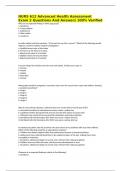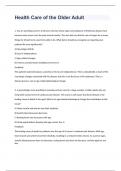Exam (elaborations)
NURS 612 Advanced Health Assessment Exam 2 Questions And Answers 100% Verified
- Course
- Institution
NURS 612 Advanced Health Assessment Exam 2 Questions And Answers 100% Verified Milia are an expected finding in which age group? a. Newborns b. Young children c. Adolescents d. Older adults A. newborns An older patient asks the examiner, "Is this spot on my chin a cancer?" Which of the f...
[Show more]




